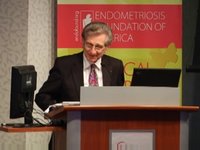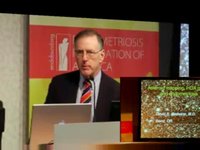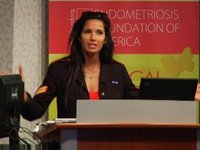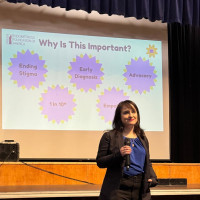We have a wonderful speaker whose teachings in laparoscopic surgery go back before laparoscopic surgery. He is the conceptual guy, one of the pioneers of microsurgery, tubal surgery, many books, many awards. He was the inspiration for many of us to pay attention to tissue planes, dissect with respect, meticulous surgery and that is Victor Gomel from Vancouver. I am very honored to introduce him to you.
Victor Gomel, MD
Tamer Seckin it is a privilege to be here in this wonderful place with so many scientists and clinicians. We had a very inspirational first session after which I was given to talk about love, not bad at all, poetic even in the morning, happiness - even better, sex - any time, and endometriosis. What an unlikely combination. I mean it is incredible. What was I going to do with this? So I thought maybe I should look at each word in an important dictionary, the American Heritage Dictionary of the English language. It says for love: an intense affectionate concern for another person, etc., you can read it yourself and it finishes, Often used as a term of endearment. Superficial. Happiness, I could not find happiness, it was at the end of happy as noun as you can see. Then I looked at sex, the property or quality by which organisms are classified according to their reproductive functions, either of two divisions designated male and female, etc. Again, I thought what do I do? I thought I would go and look at something that had more feeling. So I looked at literature and history. For love I have some quotations that are I think better than those in the dictionary. Who would give a law to lovers? Love is unto itself a higher law. Beautiful eh? You see this is 2000 years old. Only in love are unity and duality not in conflict, a famous Indian poet. Love is the poetry of the senses, Honore de Balzac. Love is an act of endless forgiveness, a tender look which becomes a habit. Isn't that beautiful? - Ustinov.
So I looked at happiness and Camus, obviously is a Nobel Prize winning and very famous author, But what is happiness except the simple harmony between a man and the life he leads. You know it is very encompassing. George Sand, whom you know was a writer and had two very famous lovers, Alfred de Musset and Chopin, says, There is only one happiness in life, to love and to be loved. And these two very famous individuals I mentioned, Musset and Chopin ended up each writing in turn a poem or a piece of music called, Tristesse or Sadness at the end of their affairs. Tristesse. Aristotle, Happiness is the meaning and the purpose of life, the whole aim and end of human existence. And Bertrand Russell says, All I can say about life is, oh God, enjoy it. And Andre Gide, one of my teachers, Behold! All of nature teaches that man is born to be happy. And how can you do that with endometriosis?
Now sex, I could not find any quotations that I could readily cite in this audience. But I am sure it is an integral part of love and happiness. And endometriosis with chronic pain, dysmenorrhea, dysparunia, pain on defecation, and depression, how could the two, the three, be together?
And indeed, surgery, and we will hear a lot about that later, is done for one of these three entities or for all of them; chronic pain, pelvic pain, infertility and pelvic mass. Endometriosis, despite all the research that you have heard this morning, is a difficult and enigmatic disease, a disease that affects women directly and her environment, partner, family, etc., indirectly, but very significantly. It affects women in their reproductive age. It is a polymorphic disease. Polymorphic disease in appearance, in the variability and severity of symptoms, some with very mild disease, a lot of pain, some with extensive disease, no pain, or both. It is frequently progressive and invasive. You can see in these images the variety, early lesions, pink lesions, red lesions, blue lesions, mixed lesions, appendix, bowels. So it is really a very polymorphic disease. Lesions that you think are very superficial could be very deep, as you can see here, and here. So, it is a difficult disease. It affects other organs, in this case the bowel. You can see the bowel exteriorated (excoriated?) during surgery.
Surgery is the primary treatment, especially for advanced endometriosis. Surgery is actually, usually the failure of medicine. I will come to that. When we look at this study, women with endometriosis in their uterosacral ligament bilateral, unilateral, we are looking here at dysparunia, sexual satisfaction, women who have endometriosis, but the uterosacral ligament is free of endometriosis and controls with no endometriosis, we see that the sexual satisfaction is much less in women, as you can see in red, which have bilateral or unilateral endometriosis, than it is in the others. As we can see the VAS score for pain is inversely proportional so that it is women who have cul-de-sac endometriosis who do have significant dissatisfaction with sexual intercourse and frequently they do not want to have sexual intercourse because of that. We can see in here for example in 30 patients for which surgery was done for cul-de-sac disease and infertility – patients who had pain. You can see that after the surgery nearly half of them became spontaneously pregnant and most of those people were able to have normal sexual intercourse after the surgery was done. So, you can see that correlation always, so happiness comes after treatment of this disease usually. Furthermore, it seems to be a disease that we are diagnosing with much increasing frequency. Is it because we are smarter now, have better diagnostic tools, or is there a factor that is making the disease more prevalent? Indeed, a lot of environmental factors are being suspected, factors such as dioxin, PCBs, etc. And God knows, all our food is contaminated, especially prepared foods. You know we treat, we feed, we produce chicken in factories? We feed them artificial foods that normally they should not be eating. The same happens with other animals, including cattle. Here, not too long ago, you see in January of this year there was 4700 chickens, turkeys and big farms closed in Germany because of dioxin contamination. All the eggs, millions of eggs, were removed from the market. Is there a relationship with that type of environmental factor?
Endometriosis is the commonest cause of chronic pelvic pain in women of reproductive age. It is estimated that 70 to 90 percent of women with CPP have endometriosis. In endometriosis, surprisingly, pelvic pain is not directly proportional to the stage of the disease. Some women with endometriosis, even with advanced stage, have no pain. We have all clinicians seen this. Many asymptomatic women who are operated for other reasons are found to have endometriosis. We have things that we do not understand.
Now, I would like to just, in two words, explain to you the difference between somatic pain and pain that comes from visceral pain. See the evolutionary function of pain transmission system is to act as a warning to the individual. The system works better for somatic pain versus visceral pain, and for acute rather than chronic pain. I will demonstrate this to you with some cartoons. Somatic pain of acute onset is well localized and easily described and draws attention to the site of the problem. Because of this you have a stimulus, a pain stimulus, and then it goes up to the spinal cord, then it goes up the thalamus and then to the higher centers and the higher centers know where the pain is, in the foot, in the leg, in your wrist. Now, when we come to visceral pain it is felt diffusely. It is poorly localized and results in intense motor and autonomic reflexes that facilitate the maintenance and propagation of the pain. This is why sometimes you have pain without having a stimulus. And the reason is this: visceral stimulus similarly will come to the primary neuron in the spinal cord. Then you will have reflex arcs, autonomic and motor. Then it is going to go to the thalamus and to the higher centers so that you do not really know exactly where the pain is. So it is much more complex.
Some interesting work has been done, for example, pathological or tissue blocks taken from the lower half of the uterus after hysterectomy. Nerve profiles were measured quantitatively and qualitatively, microneuromas, perivascular proliferations, etc. Three groups of patients were analyzed and you can see them here. The first group is chronic pelvic pain with severe endometriosis, chronic pelvic pain and no endometriosis and controls were people with no chronic pelvic pain. If you look at the first group versus control, and you can see the tremendous difference in the presence of innervation in the group with severe endometriosis and pain, and when you look at the chronic pelvic pain with no endometriosis versus control, again there is a statistical difference in the two. Then the groups where putting severe endometriosis CPP with no endometriosis with CPP and no endometriosis, you have statistical difference, and again joining the two groups of chronic pelvic pain versus control, a significant difference in nerve proliferation profile.
If we look at microneuromas alone sprouting with microneuromas, again if you take the CPP patients versus control a very big difference, and when we look at perivascular and nerve fiber proliferation you have exactly the same difference. You seem to have nerve microneuromas, perivascular nerve proliferation in patients who experience pain in the lower half of the uterus, very interesting observation. How does it happen? We do not know.
The other interesting finding, again a fairly recent study, you can see the leptin levels because leptin is a substance that influences pro-inflammatory immune responses and has angiogenic activity both in vitro and in vivo. When we look at patients with endometriosis, look at the huge level of leptin that is present in the peritoneal fluid versus idiopathic infertility and tubal ligation patients. You can see that there is a tremendous difference in the presence of leptin in the peritoneal fluid. So, there are signs that we are seeing but still we do not go to the heart. So leptin levels were positively correlated to the stage of endometriosis to ____, and pelvic pain in the patients with endometriosis.
When we look at endometriosis and depression, this is a cross-sectional prospective study on 100 women receiving care at the outpatient clinic for endometriosis. The aim of the study was to compare the prevalence of depression in women with surgically diagnosed endometriosis according to the presence or absence of pelvic pain. Endometriosis with CPP – depression in 86 percent of patients and when there is no pelvic pain there is still depression but much less, 38 percent. So, interesting findings, and the proof that really pain eventually produces the depression so frequently seen in patients with endometriosis.
I vividly remember certain patients that I have seen with endometriosis. They come to your office, they do not want to see you, they have a dislike of doctors because they have already been to several of them, they have had tremendous investigation, they have been labeled as psychotic and given psychotic medication. This lesion, missed by a lot of colleagues unfortunately, was in the posterior cul-de-sac. Visible. This particular patient came with her husband and her husband also was depressed. I assure you when this patient returned six months later I did not recognize who she was, and I was much younger then so I was not suffering from Alzheimer’s. You can see what they go through. There has been a lot of progress in imaging, in medical treatment and so on. For example you know just the simple introduction of the Levonorgestrel IUD has helped a lot of women with pain. You see here the study comparing it with giving analogues. Analogues have a lot of side effects. So, if both treatments are as effective in pain control, obviously to use such a simple device is an awful lot better. Even little progresses like this will help our patients.
But essentially surgery remains our best tool. It is very important that surgery be done very well, especially in the first attempt. It should be minimal access. It should be atraumatic, taking care of tissue, respecting tissue, it must aim at complete removal of the disease, to conserve the fertility potential in the patient who is desirous of pregnancy, and use everything to try to avoid post-operative adhesions. Despite all the progress we have experienced in imaging, in improved medical therapies and surgical techniques with minimal access, our knowledge about the disease remains limited. Surgery we do, but performed for other than trauma, congenital defects and cosmetics, surgery represents the failure of medicine: failure of having discovered the etiology of the disease and developed specific and effective, preventive and therapeutic measures. And this is valid also for endometriosis. We have seen these with vaccines. We have seen these with pulmonary tuberculosis before we knew the etiology or before antibiotics that would treat the disease were discovered. We used to do surgery, compressed the lung and so on, the iron lung. They went by the wayside. Choriocarcinoma was a very deadly disease despite surgery. Today we treat it with medications effectively and patients, many of the patients, can go and have a further pregnancy. We are even treating a lot of our ectopic pregnancies now that you could “not wait overnight” was the motto and had to operate. Now we treat a lot of them medically.
Today, stem cells were brought up. We have learned today why a lot of cancers recur despite proper chemotherapy because what we do is we kill this combination of non-tumorigenic cells and leave those very special few stem cells that do not reproduce fast like the other cells. So they stay there, the generals that are going to continue the disease and you will end up with a relapse. So, the role of stem cells, as was so well discussed this morning, is an important one that we should look at.
There are a lot of things we have to learn about endometriosis. Its etiology, mechanisms of invasion, mechanism of production of pain, why some have it and why some do not, what causes the variability of forms and presentation and the reasons for the increasing incidence. These are answers we must look for. But today, what do we do? We have to use the tools we have today and use them effectively. The physician treating such patients must have appropriate knowledge and interest in this field. Approach the patient with understanding and empathy and be willing to follow the patient as long as required. Proper initial clinical assessment and investigation is more likely to lead to a correct diagnosis and management, and thus avoid the patient to enter the vicious circle of interminable referrals with often unnecessary re-investigations and further surgical interventions. Women with endometriosis must be treated by those who have the necessary expertise in this field and interested to attend to both the physical and emotional needs of such patients.
Such an approach will permit them to enjoy “the fruits of the earth” and the triad of love, happiness and sex.
Ladies and gentleman, thank you very much.










